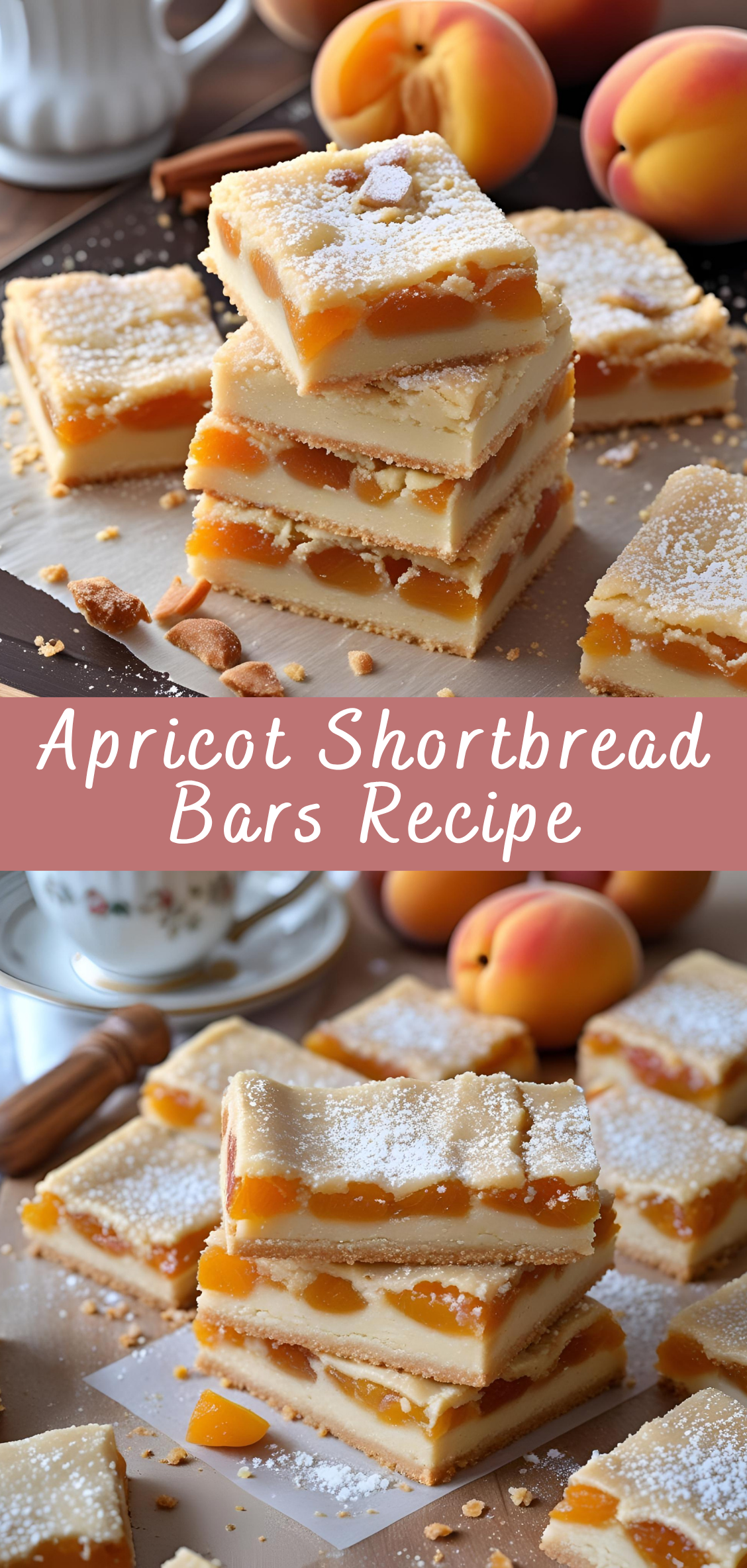Apricot Shortbread Bars Recipe
There’s something timeless and comforting about the pairing of buttery shortbread and sweet, tangy fruit preserves. Among all the possibilities, apricot stands out with its golden hue, delicate tartness, and naturally bright flavor. Apricot shortbread bars capture the essence of simple baking—where a few basic pantry staples transform into something special. These bars are simultaneously rustic and refined, perfect for afternoon tea, holiday cookie platters, or an everyday indulgence.

In the world of baked goods, shortbread has a special place. Its Scottish origins speak to a long tradition of simple, hearty baking with an emphasis on quality ingredients. When that crisp, buttery base is layered with vibrant apricot jam and topped with a crumbly streusel or second layer of dough, the result is a contrast of textures and flavors that’s both indulgent and elegant.
Apricot shortbread bars are more than just a sweet treat. They represent a bridge between seasons—the bright, sun-drenched flavor of apricots meeting the cozy richness of baked pastry. Whether you’re using homemade apricot preserves or a jar of high-quality store-bought jam, the key to a great bar is balance: not too sweet, not too tart, and a perfect contrast between tender crumb and fruity filling.
This recipe is as practical as it is delicious. With a straightforward method and ingredients that are likely already in your kitchen, it’s accessible to novice bakers yet satisfying for those with more experience. The bars hold their shape beautifully, making them ideal for slicing and serving at gatherings, packaging for gifts, or storing for days of snacking.
In the following sections, we’ll explore the history of shortbread, the evolution of fruit bars in baking traditions, and why apricot is such a standout flavor. We’ll then guide you through ingredient breakdowns, baking techniques, variations (like nut toppings, coconut layers, or even vegan adaptations), and detailed storage and serving suggestions. You’ll also find tips for troubleshooting common issues—like soggy crusts, runny jam, or overbaking—so that your apricot shortbread bars come out perfect every time.
Whether you’re baking for yourself, your family, or a special occasion, these bars are sure to become a staple in your dessert repertoire. Get ready to fill your kitchen with the aroma of warm butter, toasted flour, and bubbling fruit—because few things in life are more satisfying than homemade apricot shortbread bars.
History and Cultural Background
The Origins of Shortbread
Shortbread has a rich and storied past that traces back to medieval Scotland, where early versions were made from leftover bread dough that was dried out in the oven until crisp. Over time, this humble beginning evolved. Yeast was replaced by butter, and what was once a hard biscuit became the tender, crumbly shortbread we know today.
The word “short” in shortbread refers not to size, but to texture. In culinary terms, “short” describes baked goods that have a high fat content, which inhibits gluten formation and results in a crumbly, melt-in-your-mouth texture. Scottish bakers perfected this technique using generous amounts of butter and simple ingredients: flour, butter, and sugar.
Traditionally, shortbread was reserved for special occasions, such as Christmas, weddings, or the Scottish New Year celebration known as Hogmanay. It was often formed into rounds, then cut into wedges (known as “petticoat tails”), or shaped into bars and decorated with fork tines or sugar crystals.
As Scottish immigrants brought their recipes with them to North America and beyond, shortbread took on new forms and variations. The foundational elements remained the same—simple, rich, and satisfying—but additions like nuts, chocolate, spices, and fruit preserves became popular over time.
The Rise of Fruit-Filled Bars
The addition of fruit fillings to a shortbread crust emerged alongside innovations in fruit preservation and jam-making. In the 19th and early 20th centuries, as sugar became more widely available and home canning methods improved, jams and preserves became pantry staples. Bakers began incorporating them into desserts to add flavor, moisture, and visual appeal.
Fruit bars—essentially layered cookies with a bottom crust, a fruity middle, and a crumb topping—gained traction in American home baking in the mid-20th century. They were especially popularized through community cookbooks, church fundraisers, and vintage baking contests. Easy to transport, cut into neat squares, and made from affordable ingredients, fruit bars became a cherished treat.
Apricot, with its slightly tart, honeyed flavor, quickly became a favorite among bakers. It pairs beautifully with butter-rich pastries and offers a sophisticated alternative to sweeter jams like strawberry or raspberry.
The Apricot’s Culinary Journey
Apricots have a long and fascinating culinary history that spans continents and millennia. Thought to have originated in China or Central Asia, apricots spread westward along trade routes, reaching the Mediterranean by the time of the Roman Empire. They thrived in the warm climates of Armenia, Persia (modern-day Iran), and Turkey—regions that remain among the world’s top apricot producers.
In ancient times, apricots were considered a luxury, often dried to preserve them for use in winter. Dried apricots became a staple in Middle Eastern cooking, featured in both savory stews and sweet pastries. In Europe, particularly in France and Austria, apricots were embraced for their ability to enhance baked goods like tarts, cakes, and jams.
By the 19th century, apricots were cultivated widely in California, which still produces the majority of the United States’ apricot supply. The state’s fertile valleys and sunny climate are ideal for growing this delicate fruit, and it remains central to many West Coast recipes and traditions.
Apricot jam or preserves—often used in linzer cookies, sponge cakes, and layered desserts—offer a balance of sweet and tart that’s ideal for baking. Its bright acidity cuts through rich pastry and butter, while its natural pectin helps it set into a stable, spreadable layer that won’t weep or dissolve during baking.
A Marriage of Traditions
The apricot shortbread bar is a dessert that exemplifies the beauty of culinary fusion. It merges the Scottish love of rich, buttery dough with the European and Middle Eastern appreciation for fruit preserves. In doing so, it creates a dessert that feels both homey and refined—a treat you might find at a family picnic, a holiday dessert table, or a cozy café.
In modern kitchens, this recipe is beloved for its simplicity, flexibility, and nostalgic appeal. It evokes memories of old-fashioned baking, handwritten recipe cards, and the scent of jam bubbling in the oven. Yet it also lends itself to creative interpretation—making it a canvas for personalization with spices, nuts, and even chocolate.
Whether passed down through generations or discovered in a contemporary cookbook, the apricot shortbread bar remains a testament to the enduring appeal of combining butter, sugar, flour, and fruit into something magical.
Ingredient Overview
The success of apricot shortbread bars lies in the harmony of a few key ingredients—each one pulling its weight in flavor, texture, and structure. At first glance, the list is simple, but the magic is in the details. Whether you’re a seasoned baker or a kitchen novice, understanding the role of each element is crucial to mastering this timeless dessert.
1. Butter
Primary Role: Fat, flavor, and structure
Type: Unsalted, high-quality butter
Amount: Typically 1 to 1½ cups, depending on the recipe
Butter is the backbone of any shortbread. Its fat content is what gives the dough its signature crumbly texture and rich flavor. In this recipe, cold butter is cut into the flour and sugar mixture to create a tender, melt-in-your-mouth base. The better the butter, the better the bar—look for European-style butter if you want a richer taste due to its higher butterfat content.
Tip: Use cold butter to create a tender, flaky texture. If the butter softens too much during mixing, refrigerate the dough before baking.
2. All-Purpose Flour
Primary Role: Structure and body
Type: Unbleached all-purpose flour
Amount: Around 2 to 2½ cups
Flour forms the bulk of the shortbread dough. It interacts with the butter to create that classic “short” texture. All-purpose flour works best here because of its moderate protein content—it provides structure without making the bars tough.
Note: Avoid overmixing once the flour is added, as it can develop gluten and compromise the tenderness of the crust.
3. Granulated Sugar
Primary Role: Sweetness and crust texture
Type: White granulated sugar
Amount: Typically ½ to ¾ cup
Sugar sweetens the dough and helps with browning. In the base layer, it also contributes to the texture—giving the shortbread a slight crispness. For a subtle variation, a portion of the white sugar can be swapped with light brown sugar for a slightly caramelized note.
Pro Tip: For a finer crumb, you can pulse granulated sugar in a food processor before using, but this is optional.
4. Salt
Primary Role: Flavor enhancer
Type: Fine sea salt or kosher salt
Amount: A pinch to ¼ teaspoon
Salt is often overlooked in sweet baking, but it’s crucial. It balances sweetness, deepens flavor, and enhances the richness of the butter. Just a pinch can elevate the entire bar from bland to brilliant.
Tip: If using salted butter, reduce or omit the added salt.
5. Vanilla Extract
Primary Role: Flavor depth and warmth
Type: Pure vanilla extract (not imitation)
Amount: 1 to 2 teaspoons
Vanilla pairs beautifully with apricots and butter, adding complexity to the dough. It’s a background player, but one that rounds out the flavor profile.
Optional Variation: Try almond extract for a different twist—it pairs exceptionally well with apricot.
6. Apricot Preserves or Jam
Primary Role: Flavor and filling
Type: High-quality preserves or jam, smooth or with fruit pieces
Amount: About ¾ to 1 cup
The heart of the bar. Apricot preserves bring color, sweetness, and that distinctive tangy bite. The best results come from preserves with real fruit and no artificial flavors. You can use smooth jam for a clean look or chunky preserves for a more rustic presentation.
Homemade Tip: If you’re making your own apricot jam, simmer chopped fresh or dried apricots with sugar, lemon juice, and a splash of water until thickened.
7. Lemon Juice and Zest (Optional)
Primary Role: Brightness and acidity
Type: Fresh lemon
Amount: 1 tablespoon juice and 1 teaspoon zest
Lemon intensifies the natural brightness of apricots. A touch of juice stirred into the jam enhances its tang, while zest added to the dough or crumble gives a fragrant, citrusy note.
Pro Tip: Add lemon juice to store-bought jam to “wake it up” and reduce overly sugary notes.
8. Cornstarch (Optional)
Primary Role: Texture stabilizer
Use: Mixed into the jam or shortbread topping
Cornstarch can be used in two ways: stirred into the preserves to help thicken them slightly during baking, or added to the dough to tenderize the texture even further. It’s optional but helpful, especially if you’re working with a very runny jam.
9. Crumble or Topping Layer (Optional)
Primary Role: Texture and visual appeal
Common Additions: Oats, chopped nuts (almonds, pecans), coconut, brown sugar
A classic variation is to reserve part of the shortbread dough and crumble it over the apricot filling. For more texture and flavor, bakers often add rolled oats, brown sugar, or nuts to this topping. The contrast between the crisp top and soft fruit filling makes every bite more dynamic.
Variation Tip: Add chopped dried apricots or slivered almonds to the topping for extra flavor and chew.
10. Optional Add-Ins and Toppings
-
Chopped dried apricots: For added fruit texture.
-
Toasted nuts: Almonds, pecans, or hazelnuts for crunch and nuttiness.
-
Coconut flakes: For a tropical element.
-
Powdered sugar (for dusting): A light dusting after baking adds a classic finish.
Apricot Shortbread Bars Recipe
There’s something timeless and comforting about the pairing of buttery shortbread and sweet, tangy fruit preserves. Among all the possibilities, apricot stands out with its golden hue, delicate tartness, and naturally bright flavor. Apricot shortbread bars capture the essence of simple baking—where a few basic pantry staples transform into something special. These bars are simultaneously rustic and refined, perfect for afternoon tea, holiday cookie platters, or an everyday indulgence.
Ingredients
- For the crust and topping:
- 1 cup (2 sticks) unsalted butter, softened
- ⅔ cup granulated sugar
- ½ tsp vanilla extract
- 2 ⅓ cups all-purpose flour
- ¼ tsp salt
- For the apricot filling:
- 1 cup apricot preserves or jam (preferably with chunks of fruit)
- Optional: ½ cup finely chopped dried apricots for extra texture
Instructions
- Preheat Oven:
Preheat your oven to 350°F (175°C). Line an 8x8-inch baking pan with parchment paper or lightly grease it. - Make the Shortbread Dough:
In a large bowl, cream together the softened butter and sugar until light and fluffy (about 2–3 minutes). Mix in vanilla. Add flour and salt; mix until dough forms. It will be crumbly but should hold together when pressed. - Form the Crust:
Press about 2/3 of the dough evenly into the bottom of the prepared pan to form the crust. Prick lightly with a fork. - Add the Filling:
Spread the apricot preserves evenly over the crust. If using chopped dried apricots, sprinkle them over the jam. - Add the Topping:
Crumble the remaining dough over the apricot layer. It doesn't need to fully cover the jam — a rustic, crumbly look is perfect. - Bake:
Bake for 35–40 minutes, or until the top is lightly golden. - Cool & Slice:
Let the bars cool completely in the pan. Once cool, lift out using the parchment (if used) and cut into 16 squares.
Notes
- For a firmer crust: Chill the bottom crust in the pan for 10–15 minutes before baking.
- Want it tangier? Add 1 tsp of lemon zest to the jam for brightness.
- Storage: Store in an airtight container at room temperature for up to 3 days or refrigerate for up to a week.
- Freezer-friendly: Wrap tightly and freeze for up to 2 months.



